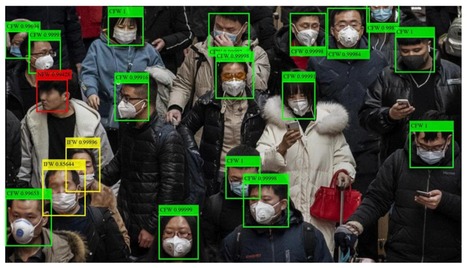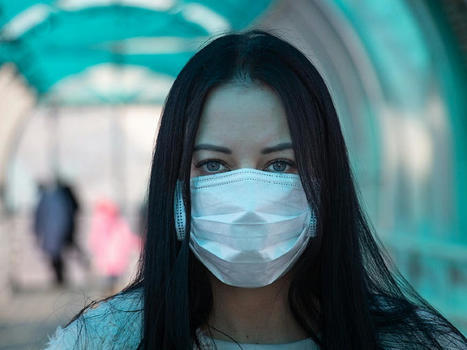 Your new post is loading...
 Your new post is loading...
The recent SARS-CoV-2 pandemic underscored the effectiveness and rapid deployment of digital public health interventions, notably the digital proximity tracing apps, leveraging Bluetooth capabilities to trace and notify users about potential infection exposures.
Digital proximity tracings showcased the promise of digital public health.
As the world pivots from pandemic responses, it becomes imperative to address noncommunicable diseases (NCDs) that account for a vast majority of health care expenses and premature disability-adjusted life years lost.
The narrative of digital transformation in the realm of NCD public health is distinct from infectious diseases.
The power of artificial intelligence (AI) in this digital transformation is noteworthy.
- AI can automate repetitive tasks, facilitating health care providers to prioritize personal interactions, especially those that cannot be digitalized like emotional support.
- Moreover, AI presents tools for individuals to be proactive in their health management. However, the human touch remains irreplaceable;
- AI serves as a companion guiding through the health care landscape.
Digital evolution, while revolutionary, poses its own set of challenges.
Issues of equity and access are at the forefront. Vulnerable populations, whether due to economic constraints, geographical barriers, or digital illiteracy, face the threat of being marginalized further.
This transformation mandates an inclusive strategy, focusing on not amplifying existing health disparities but eliminating them.
Population-level digital interventions in NCD prevention demand societal agreement.
Policies, like smoking bans or sugar taxes, though effective, might affect those not directly benefiting. Hence, all involved parties, from policy makers to the public, should have a balanced perspective on the advantages, risks, and expenses of these digital shifts.
For a successful digital shift in public health, especially concerning NCDs, AI’s potential to enhance efficiency, effectiveness, user experience, and equity—the “quadruple aim”—is undeniable.
However, it is vital that AI-driven initiatives in public health domains remain purposeful, offering improvements without compromising other objectives.
The broader success of digital public health hinges on transparent benchmarks and criteria, ensuring maximum benefits without sidelining minorities or vulnerable groups.
Especially in population-centric decisions, like resource allocation, AI’s ability to avoid bias is paramount.
Therefore, the continuous involvement of stakeholders, including patients and minority groups, remains pivotal in the progression of AI-integrated digital public health.
read the original paper at https://publichealth.jmir.org/2024/1/e49575/
Lire l'article complet sur : publichealth.jmir.org
Via nrip
The COVID-19 pandemic is the greatest public health crisis of the last 100 years. Countries have responded with various levels of lockdown to save lives and stop health systems from being overwhelmed. At the same time, lockdowns entail large socioeconomic costs. One exit strategy under consideration is a mobile phone app that traces the close contacts of those infected with COVID-19. Recent research has demonstrated the theoretical effectiveness of this solution in different disease settings. However, concerns have been raised about such apps because of the potential privacy implications. This could limit the acceptability of app-based contact tracing in the general population. As the effectiveness of this approach increases strongly with app uptake, it is crucial to understand public support for this intervention. Objective: The objective of this study is to investigate the user acceptability of a contact-tracing app in five countries hit by the pandemic.
Methods: We conducted a largescale, multicountry study (N=5995) to measure public support for the digital contact tracing of COVID-19 infections.
We ran anonymous online surveys in France, Germany, Italy, the United Kingdom, and the United States and measured intentions to use a contact-tracing app across different installation regimes (voluntary installation vs automatic installation by mobile phone providers) and studied how these intentions vary across individuals and countries.
Results: We found strong support for the app under both regimes, in all countries, across all subgroups of the population, and irrespective of regional-level COVID-19 mortality rates.
We investigated the main factors that may hinder or facilitate uptake and found that concerns about cybersecurity and privacy, together with a lack of trust in the government, are the main barriers to adoption.
Conclusions:
Epidemiological evidence shows that app-based contact tracing can suppress the spread of COVID-19 if a high enough proportion of the population uses the app and that it can still reduce the number of infections if uptake is moderate. Our findings show that the willingness to install the app is very high. The available evidence suggests that app-based contact tracing may be a viable approach to control the diffusion of COVID-19. read the study at https://mhealth.jmir.org/2020/8/e19857 Lire l'article complet sur : mhealth.jmir.org
Via nrip
Since the start of the pandemic, new technologies have been developed to help reduce the spread of the infection. Some of the most common safety measures today include measuring a person’s temperature, covering your nose and mouth with a mask, contact tracing, disinfection, and social distancing. Many businesses have adopted various technologies, including those with artificial intelligence (AI) underneath, helping to adhere to the COVID-19 safety measures. As an example, numerous airlines, hotels, subways, shopping malls, and other institutions are already using thermal cameras to measure an individual’s temperature before people are allowed entry. In its turn, public transport in France relies on AI-based surveillance cameras to monitor whether or not people are social-distancing or wearing masks. Another example is requiring the download of contact-tracing apps delivered by governments across the globe. However, there are a number of issues. While many of these solutions help to ensure that COVID-19 prevention practices are observed, many of them have flaws or limits. In this article, we will cover some of the issues creating obstacles for fighting the pandemic. Issue #1. Manual temperature scanning is tricky Issue #2. Monitoring crowds is even more complex Issue #3. Contact tracing leads to privacy concerns Issue #4. UV rays harm eyes and skin Issue #5. UVC robots are extremely expensive Issue #6. No integration, no compliance, no transparency Regardless of the safety measures in place and existing issues, innovations are already playing a vital role in the fight against COVID-19. By improving on existing technology, we can make everyone safer as we all adjust to the new normal. read the details at https://www.altoros.com/blog/whats-wrong-with-ai-tools-and-devices-preventing-covid-19/ Lire l'article complet sur : www.altoros.com
Via nrip
|
We discuss the concept of a participatory digital contact notification approach to assist tracing of contacts who are exposed to confirmed cases of coronavirus disease (COVID-19);
The core functionality of our concept is to provide a usable, labor-saving tool for contact tracing by confirmed cases themselves
the approach is simple and affordable for countries with limited access to health care resources and advanced technology.
The proposed tool serves as a supplemental contract tracing approach to counteract the shortage of health care staff while providing privacy protection for both cases and contacts.
- This tool can be deployed on the internet or as a plugin for a smartphone app.
- Confirmed cases with COVID-19 can use this tool to provide contact information (either email addresses or mobile phone numbers) of close contacts.
- The system will then automatically send a message to the contacts informing them of their contact status, what this status means, the actions that should follow (eg, self-quarantine, respiratory hygiene/cough etiquette), and advice for receiving early care if they develop symptoms.
- The name of the sender of the notification message by email or mobile phone can be anonymous or not.
- The message received by the contact contains no disease information but contains a security code for the contact to log on the platform to retrieve the information.
Conclusion
The successful application of this tool relies heavily on public social responsibility and credibility, and it remains to be seen if the public would adopt such a tool and what mechanisms are required to prevent misuse.
This is a simple tool that does not require complicated computer techniques despite strict user privacy protection design with respect to countries and regions. Additionally, this tool can help avoid coercive surveillance, facilitate the allocation of health resources, and prioritize clinical service for patients with COVID-19. Information obtained from the platform can also increase our understanding of the epidemiology of COVID-19.
read this concept paper at https://mhealth.jmir.org/2020/6/e20369
Lire l'article complet sur : mhealth.jmir.org
Via nrip
Public compliance with recommended guidelines to limit the spread of SARS-CoV-2 and COVID-19 is an important component in combating the disease .
Current guidelines suggest several measures, such as wearing a mask and staying at home; nonetheless, a large number of individuals fail to follow the guidelines provided by public health officials.
Public compliance to guidelines remains an issue
Public health campaigns aimed at curbing the spread of COVID-19 are important in reducing disease transmission, but traditional information-based campaigns have received unexpectedly extreme backlash.
Objective and Methodology: This study aimed to investigate whether customizing of public service announcements (PSAs) providing health guidelines to match individuals’ identities increases their compliance.
We conducted a within- and between-subjects, randomized controlled cross-sectional, web-based study in July 2020. Participants viewed two PSAs: one advocating wearing a mask in public settings and one advocating staying at home. The control PSA only provided information, and the treatment PSAs were designed to appeal to the identities held by individuals; that is, either a Christian identity or an economically motivated identity. Participants were asked about their identity and then provided a control PSA and treatment PSA matching their identity, in random order. The PSAs were of approximately 100 words.
Results: We recruited 300 social media users from Amazon Mechanical Turk in accordance with usual protocols to ensure data quality. In total, 8 failed the data quality checks, and the remaining 292 were included in the analysis. In the identity-based PSA, the source of the PSA was changed, and a phrase of approximately 12 words relevant to the individual’s identity was inserted. A PSA tailored for Christians, when matched with a Christian identity, increased the likelihood of compliance by 12 percentage points. A PSA that focused on economic values, when shown to individuals who identified as economically motivated, increased the likelihood of compliance by 6 points.
Conclusions: Using social media to deliver COVID-19 public health announcements customized to individuals’ identities is a promising measure to increase compliance with public health guidelines.
read the paper at https://publichealth.jmir.org/2021/4/e25762/
Lire l'article complet sur : publichealth.jmir.org
Via nrip
Contact tracing apps are potentially useful tools for supporting national COVID-19 containment strategies. Various national apps with different technical design features have been commissioned and issued by governments worldwide.
Objective: Our goal was to develop and propose an item set that was suitable for describing and monitoring nationally issued COVID-19 contact tracing apps.
This item set could provide a framework for describing the key technical features of such apps and monitoring their use based on widely available information.
Methods: We used an open-source intelligence approach (OSINT) to access a multitude of publicly available sources and collect data and information regarding the development and use of contact tracing apps in different countries over several months (from June 2020 to January 2021). The collected documents were then iteratively analyzed via content analysis methods. During this process, an initial set of subject areas were refined into categories for evaluation (ie, coherent topics), which were then examined for individual features.
These features were paraphrased as items in the form of questions and applied to information materials from a sample of countries (ie, Brazil, China, Finland, France, Germany, Italy, Singapore, South Korea, Spain, and the United Kingdom [England and Wales]). This sample was purposefully selected; our intention was to include the apps of different countries from around the world and to propose a valid item set that can be relatively easily applied by using an OSINT approach.
Results: Our OSINT approach and subsequent analysis of the collected documents resulted in the definition of the following five main categories and associated subcategories:
(1) background information (open-source code, public information, and collaborators);
(2) purpose and workflow (secondary data use and warning process design);
(3) technical information (protocol, tracing technology, exposure notification system, and interoperability);
(4) privacy protection (the entity of trust and anonymity); and
(5) availability and use (release date and the number of downloads).
Based on this structure, a set of items that constituted the evaluation framework were specified. The application of these items to the 10 selected countries revealed differences, especially with regard to the centralization of the entity of trust and the overall transparency of the apps’ technical makeup.
Conclusions: We provide a set of criteria for monitoring and evaluating COVID-19 tracing apps that can be easily applied to publicly issued information. The application of these criteria might help governments to identify design features that promote the successful, widespread adoption of COVID-19 tracing apps among target populations and across national boundaries.
read the study at https://mhealth.jmir.org/2021/3/e27232
Lire l'article complet sur : mhealth.jmir.org
Via nrip
|



 Your new post is loading...
Your new post is loading...














